Systems Alliance Military Informational Package


![]() by Grand America » Fri May 25, 2012 1:43 pm
by Grand America » Fri May 25, 2012 1:43 pm
Systems Alliance Military Informational Package

![]() by Grand America » Fri May 25, 2012 1:45 pm
by Grand America » Fri May 25, 2012 1:45 pm
The Alliance military is of great concern to the world. When they first engaged forces in Europe, they were almost entirely inexperienced. Disdain turned to respect after the relief of Shanxi, an Alliance base in Europe, where Alliance forces surprised European forces with novel technologies and tactics.
The Alliance devotion to understanding and adapting to modern warfare stunned the staid other nations. Their tactics had been seen as an amazing rewrite of what had been used by the Europeans themselves just a month before.
While competent, Alliance soldiers are professional in the sense that they can accomplish their job, though it is known they are not best in all scenarios. Their strengths lie in fire support, flexibility, and speed. They make up for lack of numbers with sophisticated technical support (drones, artillery, electronic warfare) and emphasis on mobility and individual initiative.
Their doctrine is not based on absorbing and dishing out heavy shocks. Rather, they bypass enemy strong points and launch deep into their rear, cutting supply lines and destroying headquarters and support units, leaving enemies to "wither on the vine".
On defense, the Alliance military lives by Sun Tzu's maxim, "He who tries to defend everything defends nothing." Only token garrisons are placed across Alliance Territory. While technically capable of defending a sufficient amount of time against invaders, they are intended for an overall security presence, not the defense against full-scale invasions.
However, the Alliance stations powerful fleets and forces at military nexuses so that in the event of an attack, they respond with overwhelming force. This means that, while, for example, the Caribbean is riddled with garrisons incapable of defending themselves, the strong military presence in Nightmare Naval Base in Key West is capable of arriving within twenty four hours; just short enough for the garrisons to defend against enemy invaders.
In addition to these forces stationed in nearby stations, the Alliance also deploys large numbers of patrols, radars, scanners, and satellites, in order to constantly scan the Alliance's border.
In a major project undergone by Alliance Arms, new weapons use the technology called "Mass Acceleration."
A mass accelerator propels a solid metal slug using precisely-controlled electromagnetic attraction and repulsion. The slug is designed to squash or shatter on impact, increasing the energy it transfers to the target. These weapons were criticized heavily by Alliance weapons designers. However, quickly, most of them began to see the effects such a weapon could have. Many were turned, of which almost all supported the development. With new-found support from high-ranking Alliance military officials, Alliance Arms boosted it's development of Mass Acceleration.
However, Alliance Arms saw regular ammunition as a form of problem; one that was quickly rectified by their scientists and weapons' designers.
The ammo magazine is a simple block of metal. The gun's in-expensive internal computer calculates the mass needed to reach the target based on distance, gravity, and atmospheric pressure, then shears off an appropriately sized slug from the block. A single block can supply thousands of rounds, making ammo a non-issue during any engagement. This weapon was initially developed in order to allow soldiers and weapons ease during combat, and to ensure that ammunition was less of an issue during combat than in other nations, or their military.
Utilizing projectile shavers inside the weapon, it appropriately shaves a slug from the block of metal, and fires it at an appropriate speed, blasting forward to it's target.
However, it was also known that too much heat could decompose the bullets before they are able to fire. Initially, the designers believed the only way to combat this problem was to force the soldiers to stop firing momentarily, yet constantly, in order to allow the bullets to remain composed. However, after analyzing and brainstorming with the main AI at the facility, RII (pronounced Ree; Research Intelligence Interface), one scientist, named Carlos Duncan, researched what he called, "Thermal clips." Literally, thermal clips were disposable heat sinks, allowing the gun to sink her heat quickly before a gun could be overheated. A soldier, even right out of the academy, could possibly reload thermal clips within seconds, allowing for full functionality of the weapon at all times. Each thermal clip could still allow the gun to shoot hundreds of rounds, and ceasing to fire would mean the gun would sink her heat through other means, allowing for normal cooling, and more time with a single clip.
In the event that a soldier runs out of these miniature clips, the gun could always resort to what scientists first believed would combat the issue. Though technically ineffective against other weapons, these still allow for incredible firepower, though the gun now has a special "cease fire mode" after the gun reaches near to the overheat limit. It then forces the soldier to remain unable to fire for several seconds while the cooling system cools the weapon off.
Infantry- 1 N7 Commando = 1 elite N7 operative
- 1 Fireteam = 10 soldiers
- 1 Squad = 20 soldiers
- 1 Company = 100 soldiers
- 1 Battalion = 1,000 soldiers
- 1 Brigade = 10,000 troops
- 1 Legion = 50,000 troops
- 1 Task Group = 100,000 troops
- 1 Theater Force = 1,000,000 troops
Vehicles- 1 Squad = 5 vehicles
- 1 Battalion = 120 vehicles
- 1 Division = 1,000 vehicles
Aircraft- 1 Squad = 6 Aircraft
- 1 Squadron = 24 Aircraft
Navy- Patrol = 5 warships
- Battle Group = 6-12 warships
- Fleet = 12-60 warships
- Armada = 60+ warships




![]() by Grand America » Fri May 25, 2012 2:11 pm
by Grand America » Fri May 25, 2012 2:11 pm


Alliance soldiers start off with some of the best training available, trained fully in armed and unarmed warfare, including basic sniper training. These soldiers learn how to deal with any possible situation on the battlefield; from technicals or APCs - to nuclear strikes, they know exactly how they should proceed on the battlefield. They are equipped with exo-skeletal suits and advanced technologies to complete battlefield tasks with ease. They are an overall powerful force, and certainly a powerful arm to the Alliance military branch.

An innovation of unmanned, armed combat drones, the Hammer is capable of having a single, yet powerful, 32 mm-round Mini-gun. Below it, 2 small launchers with 12 miniature rockets, capable of breaking through an Armored Humvee's armor, giving the Hammer an upper-hand in combat. Design specifically for the uses of troop support, the missile systems are capable of being reloaded, as well as targeting low and hovering aircraft. While not specifically designed to destroy them, the missiles can break through with enough force to damage a large set of gadgets and weaponry, effectively taking it out of commission. However, for aircraft, such as helicopters, the missile is known for it's lethality, as a single shot in the rotors breaks them off, and destroys the target.
After several tests, simulations, and simulated combat situations, it is believed that the Hammer Drone is a successor of the PD-6, and has been adopted as the Alliance's main Combat Drone.

The Archer (Alliance's Intelligence drone) was designed specifically to be an advanced intelligence asset in the field, gathering and transmitting intelligence to the troops on the ground who need it. While technically outmatched in a fight against regular army troops, and definitely against a Hammer, the Archer drone does carry with it an LRAD when unexpectedly engaging a large amount of enemy forces, as well as a THEL to eliminate small teams or lone soldiers that are or might attempt to reveal its presence to others.
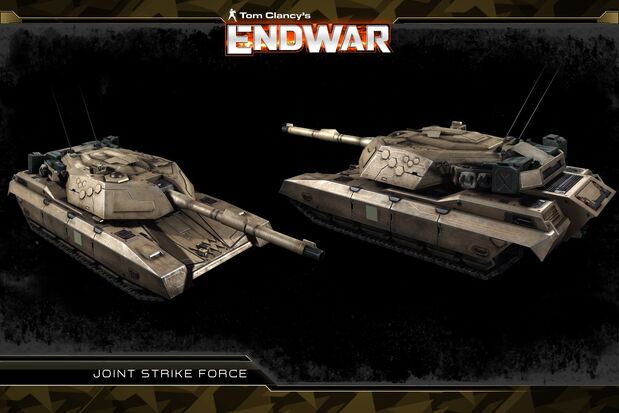
This Heavy tank is the pride of the advanced arsenal for the Alliance, and it's easy to see why. She is capable of enduring massive punishment, while dealing out the same. Its 120mm Smoothbore is capable of blasting apart enemy fortifications, while its advanced fire control system gives it unsurpassed accuracy.
The M5 is a very powerful machine. It has both older weapons, like the 120mm Smoothbore, and newer weapons, such as the RAVEN 20mm Minigun. This mix makes a deadly combination, giving the M5 the power to go against several different types of targets. Its state-of-the-art fire control system gives the M5 accuracy previously unheard of, making rivals with even the most advanced tanks anywhere in the world.
This mounted combat system is yet another example of the end results from the Future Combat Systems Program. While its primary armament, a 120mm Smoothbore cannon, is essentially unchanged from tanks of previous generations, the rounds it's capable of firing are updated to be much more punishing.
The M5 can even be equipped with an advanced active defense system, the High-Explosive Shield (HES), which provides added protection against an array of high-explosive anti-tank (HEAT) weaponry in the form of hardened outer hulls.
The M5 follows the requirements of the FCSP, and is EMP-Protected.
Vehicle Details
Armament: 120mm Smoothbore gun, co-axial 7.62mm MG, RAVEN 20mm minigun
Height: 8'3"
Length: 33'1"
Width: 12'0"
Weight: 40 tons
Crew: 4
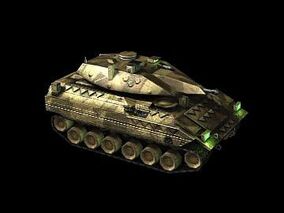
Upon first inspection, the M118 Fastback looks like little more than an updated version of infantry fighting vehicle designs used at the close of the 20th Century. However, it represents a huge leap forward in IFV design. It is capable of engaging both ground and airborne targets and can quickly provide transport for a full squad of riflemen or engineers. Faster, more fuel-efficient, deadlier, and tougher than its predecessors, the Fastback incorporates many features pioneered by the Future Combat Systems program.
The Fastback also includes plenty of electronic countermeasures, including an Anti-EMP coat, allowing it to operate even under an EMP strike, and is fully "wired" according to specifications set by the Future Combat Systems program.
The Fastback's ability to fire TOW Missiles gives it an increased edge over enemy helicopters, as well as other enemy tank forces in the field. A special feature of the Fastback is her ability to be used for amphibious operations, using special rudders and buoyancy enhancers on the outer hulls of the transport.
The Fastback follows the requirements of the FCSP, and is EMP-Protected.
Vehicle Details
Armament: AA rail gun, co-axial 7.62mm MG, TOW-IIIA
Height: 9'9"
Length: 21'2"
Width: 10'6"
Weight: 25 tons
Crew: 3
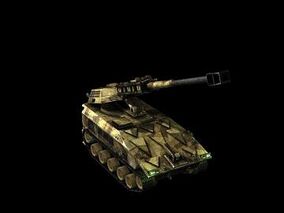
Nothing scares enemy soldiers more than artillery fire. When the Alliance military wanted to replace its older units, it wanted a brand-new SPG, beginning with a gun.
The Spartan, utilizing the 165 mm round, is capable of shooting at an impressive rate of 1 round every 4 seconds, giving them the ability to destroy enemy targets, not only with deadly accuracy, but with immense strength.
Artillery fire from a few Spartans will wreak havoc, completely obliterating enemy defenses, but the Grid Smasher's rocket launchers, a single M320 can destroy a city block in seconds. Such intense support allows them to being shooting at defensive lines, and destroy soldiers in seconds, allowing other units to move, unmatched.
The Spartan follows on of the requirements in the FCSP, and is EMP-Protected
Vehicle Details
Armament: 165mm gun, two 32mm MGs, Grid Smashers
Height: 10'5"
Length: 29'6"
Width: 10'1"
Weight: 26 tons
Crew: 4
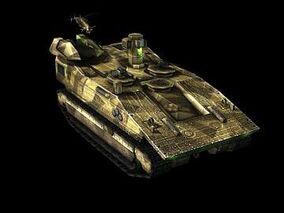
C1A5 Archons can provide a valuable tactical edge on the battlefield. Each one of these high-tech vehicles is equipped with a dizzying array of computers, sensors, and other tools for information gathering and distribution, including the extremely valuable Tac-Map. The Archon is a one-stop shop for all C5ISR (Command, Control, Communications, Computers, Combat Systems, Intelligence, Surveillance, and Reconnaissance) needs. Placing a C1A5 Archon on the ground will give commanders drastically enhanced battlefield awareness and allows for the detection of traps and stealth units. While not as effectively as an L/B Satellite, the C1A5 is fully capable of obliterating enemy electronics. The EW Suite on the Archon provides radar and communication jamming, stealth technology, and computer network hacking, as well as the ability to detonate an EMP. These suits, as well as the vehicle herself, is EMP-Protected.
Vehicle Details
Armament: 20mm chaingun
Height: 12'7"
Length: 38'2"
Width: 13'0"
Weight: 11 tons
Crew: 6

The General ARea Defense Integration Anti-spacecraft Network (GARDIAN) consists of anti-missile and anti-fighter laser turrets on the exterior hull. Because these are under computer control, the gunnery control officer needs to do little beyond turn the system on and designate targets as hostile.
GARDIAN lasers typically operate in infrared frequencies. Shorter frequencies would offer superior stopping power and range, but degradation of focal arrays and mirrors would make them expensive to maintain. Most prefer mechanical reliability over bleeding-edge performance where lives are concerned.
Since lasers move at light speed, they cannot be dodged by anything moving at subluminal speeds. Unless the beam is aimed poorly, it will always hit its target. This allows the GARDIAN to be an effective anti-satellite weapon, as well as being rather effective against fighters. Alliance Arms developed this weapon to replace the GASM, which was seen as ineffective in a combat operation. However, it is known that the GARDIAN lasers are used against fighters and missiles as well.
Seen as a wonderful replacement, it has been adopted as the Alliance's anti-satellite weapon.

After countless tests in fruitless attempts to update the old Scryer Drones, Alliance Arms announced that it was no longer going to produce said weapon, and was going to design a new combat drone for the Alliance Armed Forces. Shortly thereafter, the Luna-Class was revealed.
The Luna-Class was designed carefully, as to be capable of heavy combat operations, in which assistance to soldiers is crucial. A strong, but heavy drone, the Luna is forced to stay closer to the ground than the Scryer could, though is still capable of high lifts.
The Luna was initially designed with a small 20mm minigun, and a small block that could supply only a few hundred rounds, as it was meant to operate near soldiers who could refill her with extra blocks. Further into the development, however, Alliance Arms felt it was necessary to add missiles to the drone. To comply, four Mini-JSMs were added to the weapons, as well as a small LRAD, to disorient enemy soldiers.
Seen as a major improvement over the older and outdated Scryer Drone, the Alliance Defense Council gladly accepted the new Luna-Class Heavy Combat Drone.
The M1114 Alliance Humvee is a 4-door, hydrogen-powered, 1.25-ton capacity utility vehicle capable of operating in some of the toughest terrain. The M1114 is 16.2 feet long, 7.5 feet wide, and is 6 feet tall. It is equipped with an automatic transmission and in most configurations provides seating for four passengers. They can be armed with a variety of armaments on the roof, including a rocket launcher and a minigun. Its CROWS weapon system on the roof is very efficient in engaging helicopters and other lightly armored vehicles. This vehicle was created directly for the necessity to have small, compact, and fast moving vehicles to use when in urban environments. It's armor is sufficient against small arms fire, and her compactability allows soldiers the ease of protection while driving through these dangerous environments.
However, it was added, further in development, her ability to cross more hostile terrain, such as sand dunes or mountainous areas, in order to achieve a more universal strength.







![]() by Grand America » Fri May 25, 2012 2:22 pm
by Grand America » Fri May 25, 2012 2:22 pm



The Serpent-Class Ballistic Submarine is considered one of the most advanced war machines ever to roam the earth, utilizing advanced technologies to give it an edge over enemy ground targets all over the world. Her Tomahawk V-2 Missiles allow her to, while still at sea, hit targets 2,000 miles away with near-deadly accuracy.
Over the deck of the submarine are 18 pods, with Tomahawk V-2s ready to be fired on a moments notice. In the storage of the submarine, it carries another 90 missiles, to be used on any occasions. Also, in a separated storage, are 18 nuclear warheads attached to Tomahawk Missiles. These allow it to, should it deteriorate as much as to do so, the Serpent-Class is a nuclear asset in the modern world.

Designed to be one of many missile assets already deployed in the seas, the Tiger-Class' priority is missile dominance. That means: Being able to deploy more Tomahawk V-2s than any other vessel in a combat zone, as well as deploying defensive missiles to protect Alliance or allied fleets.
The Tiger's defensive system consists mostly of Low-yield warheads inside of Tomahawk V-2s, aimed and fired at enemy missiles, allowing it to, for a smaller amount, destroy enemy missiles, effectively protecting it's aerial vulnerability. For naval vessels, while technically undefended against depth charges or miniguns, it's large missile arsenal allows it to quickly deploy missiles to sink enemy targets. For enemy submarines, it uses a "fake" torpedo with a low-yield warhead, designed to knock into the enemy torpedo, explode, and either destroy or derail the torpedo.
The Tiger's offensive system consists of approximately 400 missile pods placed all across the deck of the ship, each with a single missile inside. In the Weapon's Cache, there are enough missiles for each pod to fire twice, giving it an amazing overall capability against enemy ground or naval targets, and utilizes a smaller-yield warhead in a Tomahawk V-2 to eliminate aerial threats.
Much like the Serpent-Class, the Tiger-Class Missile Ship carries 125 nuclear warheads in a separate storage container, giving it a nuclear advantage in the oceans.
The Tiger-Class has been effectively adopted as the Alliance's Missile Ship, becoming the real first of it's kind for the Alliance Navy.

Possessing more firepower and protection than a frigate and a greater cruising speed and maneuverability than a Battleship, cruisers are the standard combat unit encountered away from large naval bases and form the backbone of the fleet. Cruisers lead frigate “wolf pack” flotillas in small engagements and fulfill a supporting role to the battleships in full scale fleet combat.

The Main troop transport of the Department of Foreign Defense in Alliance, designed with some of the best technology that the government could purchase, it's amazing speed and capacity make it a favorite of all commanders. While capable of transporting a total of 4,000 troops, and it was designed to carry smaller transports. The Spear is designed to carry a total of 20 soldiers, fully armed, into a combat zone. However, the Sword is a far larger version, used to carry tanks (or an entire battalion of troops) onto a field of battle.

Sword Transport - Larger version of the Spear
However, the Spearhead can also double as a Cargo ship, carrying much-needed supplies to soldiers.

Generally smaller craft, operated by about 120 people, they work in teams of 10 to move around small encampments and destroy enemy ground targets. They are faster than most other craft in the Navy, allowing them to be one of the first to reach the battlefield. With this in hand, they can give naval support to any Marines that need it before the real battle even begins.

Frigates are light escort and scouting vessels equipped to screen and support the fleet. They are outfitted with defense turrets to provide anti-fighter screening for capital ships and torpedoes to take down opposing ships. In fleet combat, frigates are organized into "wolf pack" flotillas of four to six ships. They use their superior speed and maneuverability to evade and maneuver into the opposing fleet to take down enemy ships, though also carry around with them AA lasers to give them superiority over the rising threat of aerial attacks on naval targets.

A large vessel, carriers are instead equipped with extensive hangar bays, using fighters and interceptors as their primary offensive armament. In fleet combat, carriers launch their fighters and/or fighter/bombers and then try to stay clear of the action, though they carry Anti-Naval and Anti-Air weapon systems as a defense. This carrier class is capable of carrying 40 planes.

Basically a larger version of the Carrier, this ship is capable of carrying near to 72 planes in its hangers. The Super-Carrier is far more expensive than a regular one, but, due to it's massive advantages in the field, is a larger focus than the Carrier. While less Super-Carriers have been built than Carriers, they are more deployed far more often, and pose a larger threat to Alliance enemies.

As one of the most valuable assets in the entire Alliance Navy, the Mercy-Class is a hospital ship of incredible size, burdened with the duty of assisting wounded military personnel. Being so deeply deployed into combat zones, the Mercy-Class is armed with few CIWS stations, as well as missiles, and lasers, as all Alliance Navy ships must. While not incredible in the regular combat role for the Alliance Navy, the Mercy-Class has proven to be a valuable asset in many different situations.
The Mercy-Class has enough space for nearly two thousand five hundred patients, and enough medical supplies to treat them for prolonged periods of time.



The largest ships, and always the capital ships when deployed, the moment these ships appear, it tends to be a game over for the enemy. While the Alliance has only about 20 of these monsters of war, they are wisely deployed to be able to oversee any overseas operations the Alliance is carrying out. Each Dreadnought Carrier can carry near a total of 95 aircraft, and is equipped with hundreds of turrets and missiles for anti-air and anti-naval defenses defenses. These beasts of war are always escorted by an appropriate battle group, and tend never to disappear from Alliance Fleet Command, as they are the most important asset in the seas.

The United-Class is Alliance Arms' first, and best, Amphibious Assault Ship.
It's design incorporates mainly the use of UT-47 Ascension Drop Shuttles, to allow Alliance Marines to deploy offshores. In terms of job designation, it's just a smaller Spearhead; However, the United-Class can deploy aircraft, excluding helicopters, while the Spearhead cannot. This gives this class a massive advantage over her enemies, and allows her to deploy a far more diversified force, rather than helicopters and naval forces.
While it's main purpose is still to be an amphibious assault ship, it had the deployment of multi-role fighter craft in mind.
Because of so, each United-Class carries with it 12 X-35 Lightnings, as well as 4 Blackfoot gunships, giving it the boost over the Spearhead troopship.
After undergoing countless tests, like all other weapons, it has been adopted as the Alliance's first Amphibious Assault ship.

The very first of it's kind, and a revolutionary weapon system, the America-Class Cruiser is a large, flying ship, operated by some 425 personnel. Designed to be a strike unit, rather than a transport, the America-Class is one of the most capable strike attack forces on the planet. Capable of carrying not just thousands of 145 mm rounds, in countless cannons on the "belly" and sides of the ship (as well as the front), it carries several hundred missiles, fired from 6 different missiles ports (4 on the top, 2 in the front). This allows the America-Class to be an effective, while expensive, asset in the field of battle.
Slightly more than 640 meters from front to back, the America-Class' size does limit where she can land, and her maneuverability. It was not designed to be capable of sharp, fast movements, but rather, as a strong vessel, capable of destroying enemy ground targets cleanly. While currently, the only place she can really land are re-fitted air bases in the Alliance, it is expected that allies will attempt their best to allow ships to land.
Knowing of her limits against landing in specific areas of the planet, it was designed with a small hanger, capable of fitting just 3 Valkyrie transport helicopters. This allows the fuel, supplies, and munitions needed to be transported up to an America-Class regularly, and with sufficient abilities. Never-the-less, the Helium-3 already on board, the supplies necessary for the survival of the crew, as well as the ammunition counts on each vessel, allows her to stay afloat and operational for more than 90 days.
In order to defend itself from projectile, the America-Class is "surrounded" by a Kinetic Barrier, which works to stop projectiles (Triple-A, missiles, etc.). This allows the shield (CBT, Cyclonic Barrier Technology) to protect the entirety of the America-Class from most weapon systems, excluding lasers (however, lasers are less effective against hard targets, and so, is weaker against the hull of the America-Class than other weapons). However, because it does absorb the linear force of the incoming projectiles, at some point, the barrier must be turned off, to avoid overloading systems in the ship.
Since the weapons the ship carries herself are projectile weapons, the designers created a slightly more complex system, to allow the ship to continue using her projectile weapons. All weapons, while "sticking out" of the ship, only have the barrel opening on the outside of the kinetic shield. This allows the weapon to by-pass the shield without interruption, and can still affect targets ground-side. After firing it's round, while unloaded, the barrel retracts behind the shield, covering it. This allows the ship to continue firing it's weapon without exposing itself past the shield.
However, this shield has her limits, and will, under pressure, be forced to be disabled.
While being able to only launch from Alliance Air Force bases, every ship and their personnel are under the Navy's jurisdiction.General Characteristics
- Class and Type: America-class Aerial Cruiser
- Length: 646 m
- Width: 323 m
- Complement: 425 Personnel (excluding one company of marines)
Armament- 6x Double-Missile pods - 120 missiles in storage
- 54x 145mm Cannons
- 18x Anti-missile pods
- 24x S-32 CIWS cannons
- 6x Mortars
- 2x Artillery cannons
Counter-Measures- Chaff and Flare systems
- FELs and SSLs
- Kinetic Barrier
- Anti-Aircraft missiles
- 36x minguns
Power- 3 Helium-3 Reactors
- 3 Clusters of 4 Pulsejets
- Fuel: H2
- Range: Unlimited
- Max Speed: 104 Nautical Miles
- Slowest speed: 29 Nautical Miles
Additional Specs- On-board Artificial Intelligence (EDI- Enhanced Defense Intelligence)
- Long-Range Scanner (1,800 miles)
Hanger Specs- Has enough space for the landing of 3 Valkyrie transports
- At all times, carries a single UT-47 Ascension drop shuttle
The landing system of the America-Class is different from other designs of aerial craft - The America-Class, at her very bottom, as large, retractable, padded poles, which allow the America-Class to touch down on landing pads and tarmacs; However, these must be of enormous size, in order to allow the America-Class to comfortably land. The America-Class can, while not technically a VTOL aircraft, does not need long runways in order to land. By lowering the intensity of the Anti-proton thrusters, she can go at extremely slow speeds, allowing for a quick landing. However, the width of the runway must be larger, to accommodate the America-Class' larger size.
Built - 32
- ANV Stockholm
- ANV Thunder-Bird
- ANV Cerberus
- ANV Sovereign
- ANV Arcturus
- ANV Reaper
- ANV Hydra
- ANV Widow
- ANV Avenger
- ANV Harbinger
- ANV Supernova
- ANV America
- ANV Blackbird
- ANV Aurora
- ANV Echelon
- ANV Royalty
- ANV Rapture
- ANV Blitz
- ANV Catastrophe
- ANV Trident
- ANV Dreadnaught
- ANV Spirit
- ANV Paladin
- ANV Earth
- ANV Guardian
- ANV Warden
- ANV Terminus
- ANV Champion
- ANV Valkyrie
- ANV Mattock
- ANV Revenant
- ANV Valiant

![]() by Grand America » Fri May 25, 2012 2:34 pm
by Grand America » Fri May 25, 2012 2:34 pm


While designed to have a massive payload and be capable of flattening any targets, it was also designed to be stealthy. It's advanced stealth capabilities allow it to evade radar and, at night, can easily evade detection in the dark while still successfully striking it's targets.
While it does carry a massive payload for regular "dumb bombs", the B-60 was actually designed to carry strategic guided warheads, even Tomahawks, to their targets, and can obliterate targets quickly and quietly. Not as agile as the XB-22, but has a far larger payload.

The Spectre-320, regularly called the "Spectre", is the Alliance Arms' response to pylon-turning gunships. Perfectly capable of eliminating ground targets precisely and with great force, the Spectre has been considered one of the most important assets in the Alliance's Air-to-Ground combat roles.
A modified version, the Spectre-325, is an AWAC, of sorts. It carries a Long-Range Scanner, similar to that of an America-Class, and uses it as a regular AWAC would use it's own scanners.



The Alliance Arms X-35 Lightning is a fifth-generation, single-seat, single-engine, stealth-capable military strike fighter, a multirole aircraft that can perform close air support, tactical bombing, and air defense missions. While not capable of replacing the XA-20 in CAS, the XB-22 in tactical bombing, or the X-16 in Air Defense, it is to be a major addition to the already large air fleet in Alliance possession, and surely to be used effectively as the major upcoming Multi-Role fighter.
The X-35's VTOL and STOL capabilities allows it to be an extremely advanced asset; Far superior than the Harrier before it.
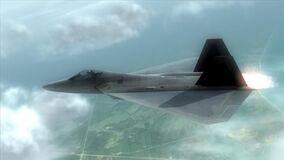
Essentially an X-22, it was redesigned to allow for a far larger payload and range, transforming it into a stealth bomber. While less capable in a dogfight than the X-22, the Raptor is easily better for stealth strikes, though still undermined by the XA-20 in Air Supports.



Recently, it had come to the attention of Alliance Arms that whatever old and useless UCAVs the Alliance Air Force was deploying (primarily the Predator Drone) was extremely loud, and easily spotted by SAMs and other types of aerial defenses. While the Alliance hadn't been deploying many Predators, they asked for an upgrade. It came in the shape of the Grim Reaper.
While one of the most stealthy recon drones Alliance Arms has ever created, it is perfectly capable of long-term recon missions, as well as carrying a missile payload of about 3 tons, or 6,000 pounds. Surely, the Grim Reaper was not designed to be a drone with a combat role; It's a stealth drone.
Because of it's amazing capabilities for stealth recon, the Alliance has adopted it, and decommissioned the X-170.

Alliance Arms, after several months of experimenting with different designs, finally finished the Galactic Eagle. Designed to be one of the largest military transports, it can move troops in and out of an occupied, or combat, zone, with ease, as well as transporting several other vehicles. However, while more weight-capable than the Valkyrie, it is incapable of landing in hot combat zones, as it needs a runway. However, the transport is still considered a vital asset by the AMC (Alliance Military Command), and has been adopted as it's long-distance transport plane.
However, there is a smaller version, the Global Eagle, which is a tactical airlifter, capable of cheaply moving troops around the theater.

The V-120 Valkyrie is deployed onto the battlefield with the sole purpose of landing friendly vehicles and getting them into the fray as quickly as possible. This air vehicle's design is based off of that of the V-25 Goshawk troop carrier, except it has a larger body for transporting IFVs and tanks. It is designed to be able to carry the 4 of the heaviest vehicles in the Alliance arsenal, the M5 Havoc tank.

Small and agile, this drone is mainly designed for short range recon missions, gathering as much intelligence as possible on its targets. The blue "eye" in the center is central to the intelligence gathering goal of the drone, but also carries a small laser to destroy minimal threats, such as troops with missile launchers, or groups of infantry. Along with such weapons, it also carries 2 Mini-JSMs (82-pound warhead), should it need them. However, it is not designed to stand a fight, and the laser is designed to defend the craft until it is capable of returning to its Lift-Off zone, with its VTOL capabilities allowing it land virtually anywhere. In the event that the drone is shot down, the laser activates an Over-Heat procedure which fries the drone, making it no more useful than a hunk of metal.

A completely redesigned and fresh plane, the XA-20 is the main project for replacement of the A-20. Being just as durable, fast, and have similar payloads just wasn't enough. Instead, it's newer, thicker armor provides much better defense for the single pilot inside of the plane, it's better engines and thrusters provide a faster speed, giving it an advantage to run from an area of combat, should it be necessary, and it's larger payload gives it a handy advantage for it's main purpose; Stealth ground support. While technically still capable of Air-to-Air combat, it'd design was almost wholly placed on the aspect of it replacing the A-20 as the Alliance's Close-Air-Support plane. With it being able to carry any weapon the A-20 could, and more, it's future seems bright, as the Alliance officially adopts it as it's main Ground-Support plane.
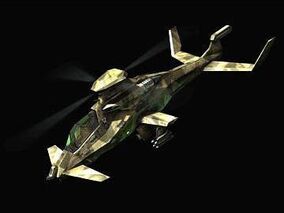
The Blackfoot is a stealthy, highly agile gunship that represents the latest in helicopter design. It is equipped with an advanced fly-by-wire system.
The AH-80's targeting systems are very advanced, too. Earlier designs were connected with the gunner's helmet, but in the AH-80, the targeting system monitors the eyes, making it way more accurate. Once a target is picked out, her 30 mm minigun is capable of punching holes right through the target. The Blackfoot is also equipped with several Joint Strike Missiles, making it a deadly tank-killing helicopter.
The canard rotor/wing spins but can be fixed to act like a wing. Early pilots were worried by the aircraft's lack of a tail rotor, but after going up in the air, their concerns disappeared. The canard rotor/wing allows the AH-80 to perform an array of aerobatic maneuvers, giving it incredible maneuverability compared to other helicopters.

The UT-47 is a personnel carrier, designed to transport troops to and from battle zones with amazing capabilities. While having four thrusters, two in the front and back, giving her the capability of going backwards and forwards at optimal speeds, she also has several different thrusters on the bottom, which allow the aircraft to push itself up and down. Designated a VTOL aircraft, the UT-47 was designed by Alliance Arms in order to supplement the projection capabilities of the Alliance.
Nicknamed the "Combat Cockroach" by Alliance marines, due to its durability and looks, the Ascension drop shuttle is operated by a pilot and a co-pilot, as well as two gunners. Added to those, the UT-47 also carries a small computer system, which detects and warns the pilots whenever there is an imminent danger - that includes AA guns, missiles, fighters, heli-jets, anything that could pose a threat to the UT-47. However, she is not extensive, and is an extremely limited system, due to the Ascension's lack of enough space.
For her defensive purposes, the UT-47 carries, next to the front thrusters, two large mounted weapons. Each carries one 20mm mini-gun, which tracks targets chosen by the target gunners. As well as the mini-guns, it carries a small 20mm cannon, used to fire slowly, yet accurately, at large structures. It's bigger punch allows it to be used for more threatening manners, rather than obliterating ground troops. It can be used, to a point, to destroy tanks.
Because of the Ascension amazing test results, and her ability to be controlled by concentrated pilots, even under heavy fire, have forced the Alliance to lay down the Goshawk as her main transport helicopter, and watch as it was replaced by the UT-47 Ascension.

![]() by Grand America » Fri May 25, 2012 2:36 pm
by Grand America » Fri May 25, 2012 2:36 pm



The N7s are the Alliance's Special Operation's forces, and carry out missions all over the globe that must be dealt with extreme care and secrecy. Trained to be some of the best soldiers in the field, they are often deployed with some of the most cutting edge technology in the world. This includes an Optical-Camouflage that uses meta-materials to bend light around them rather than reflect off them, effectively allowing them to blend into their surroundings. In addition, they also have shoulder-mounted rocket systems; One launcher over each shoulder, and each launcher carries 3 18-pound rockets.
All N7 operatives, to join the program, must pass ACT; Alliance Combative Training.
The Alliance Combative Academy, sometimes called "N-School" or "the villa," recruits officers from every branch of the Alliance's militaries to partake in grueling courses, many far worse than most other programs across the planet.
Initially, candidates train for more than 20 hours per day, leading small combat teams through hostile terrain with little sleep or food. Trainees who do well are awarded an internal designation of N1 and are invited to return. Subsequent courses - N2 through N6 - are held in all different environments around the Alliance, and include instruction in, military free-fall (parachuting), combat diving, combat instruction, linguistics, and front-line trauma care.
The highest grade of training, N6, provides actual combat experience in combat zones throughout the galaxy. If the trainee survives these scenarios in "admirable and effective fashion," he or she finally receives the coveted N7 designation. If not, the operative is, while not accepted into the N7 Special operations forces, sent to other forces. Many that participate, but do not make N7, are directed towards the Joint Strike Force, of which many join.
There is little shame in failing an N course - the training is so extreme that even qualifying for N1 elevates an officer to a position of respect. The universal prestige of merely attending the academy helps to restrain trainees from taking excessive risks in pursuit of higher honors.
Although ACT qualification by itself does not guarantee higher rank, those officers who are able to complete the program are typically well suited to senior leadership positions.

![]() by Grand America » Fri May 25, 2012 2:41 pm
by Grand America » Fri May 25, 2012 2:41 pm

A Kinetic Strike, nicknamed Rods from God, is a space-based weapons system created by the Alliance.
The kinetic kill vehicle launch platform consists of a satellite armed with 12 telephone pole sized Tungsten rods loaded into 12 launch tubes mounted on one end of the satellite . The satellite employs high efficiency photo-voltaic panels or "wings" to generate electricity directly from sunlight. The satellites are then placed in orbit and must be reloaded after each use, or de-orbited and a replacement launched. The current Alliance system consists of an unknown number of such satellites, with that information being classified and hidden behind the Alliance Firewall.
The rods are made of Tungsten, and on their tip is a heat shielding material, reinforced Carbon-Carbon. On the back of the rods is a rocket motor, which fires once the rod has separated from the satellite. The motor powers the rod to a speed of 36,000 feet per second, and sends the rod into Earth’s atmosphere, eventually smashing into the crust. The rods are twenty feet long and one foot in diameter.
This, coupled with the speed, causes the crust to crack, spewing dirt and tearing up the ground as the shockwave travels, and is considered one of the most dangerous weapons in the Alliance Arsenal.
The yield of this weapon reaches to about 8 kilotons of TNT


These satellites were originally designed as logistic satellites, but were later upgraded with laser systems capable of breaking through armored trucks and some weakly armored tanks. It is easily capable of breaking through a building, though not destroying it, and ideal for striking large groups of infantry forces.
It also carries with it a Electronic Warfare suite, capable of shooting an EMP anywhere on the planet in seconds.
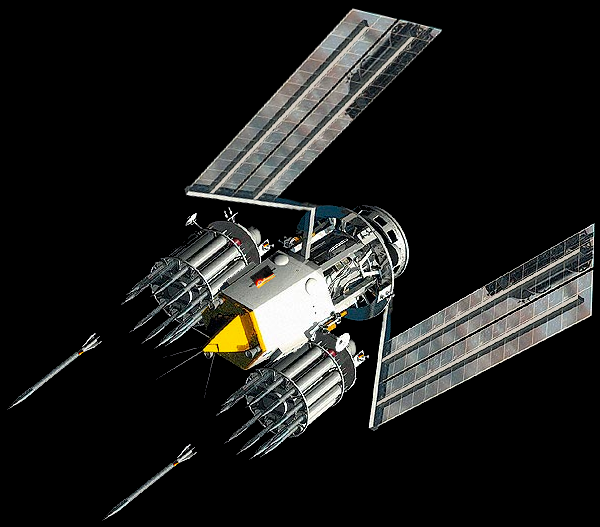
A new version of a satellite orbital weapon specifically designed to be capable of destroying ground targets with deadly accuracy, as well as massive damage, Alliance Arms designed the Everest-Class in order to replace to costly RoG. While technically incapable of having such an impact, unless fitted with nuclear weapons, the Everest-Class is still an amazingly powerful weapon, and is to replace the RoG in several different theaters, without completely withdrawing her from the Alliance arsenal.
The Everest-Class is a small satellite, fitted with 16 modified Tomahawk Missiles. Acknowledging the fact that the satellite needed to be a greater asset than any other weapon, the Tomahawk in the satellite, now called the 'Everest' is a similar-looking missile, though carries a far larger payload - nearly 10,000 pounds of explosives are held within her warhead. Her new, and massive, payload allow her to be a productive member of the Alliance's Orbital Weapons Program. However, taking note of the necessity of a defense against a weapon system built to destroy orbital weapons, like ASAT missiles, a small, yet effective, THEL system was built in, to protect itself.
The Everest was constantly tested in isolated environments and weapons testing sites, and has been approved by the Alliance Defense Committee as a new orbital weapons platform.

![]() by Grand America » Fri May 25, 2012 2:49 pm
by Grand America » Fri May 25, 2012 2:49 pm

Originally designed to be a Cruise Missile, with the intention of obliterating ground targets, the V-2 has shown significant abilities in taking down and eliminating aerial and naval targets as well, allowing it to be an extraordinary asset on the battlefield. It's ability to fly at speeds exceeding 3,600 mph, it's 3,200 pound warhead gives it a major boost in a battle, only adding to the V-2's amazing capabilities.
While never yet having been necessary, the V-2 can be outfitted with a variety of nuclear warheads.

Following the clear necessity to allow Multi-Role Aircraft, such as the X-35 Lightning, to, at any time, hit both air and ground targets, Alliance Arms developed the Joint Strike Missile.
Designed to be able to track and destroy aerial, naval, and land targets, the JSM's ability to hit ground and air targets gives even Air Superiority fighters the ability to hit ground targets, whether or not they were developed for such a role.
This development proves to be crucial for the upcoming advances in the Alliance arsenal, as they move forward with more effective weaponry systems.
Capable of speeds exceeding 3,000 mph, it's 320 lb warhead is lethal against all targets. However, in order to extend her service to the EagleEye and the Scryer drones, the "Mini-JSM" was developed. Retaining the same speed, the warhead is a smaller 82-pound, allowing it to be fitted onto the more agile vehicles.
Inertial and/or GPS guidance.

After other nations' effective use of incendiary weaponry, Alliance Arms built their own; The X82. Designed to be as effective, if not more, than most state-of-the-art napalm weapons, the X82, using an extremely intense amount of white phosphorus, is capable of spreading massive fires across it's target.
While the X82 works like any regular napalm bomb, the X82-1 works like a Cluster bomb; Inside the main package, it carries hundreds of small droplets, that, when dropped, explode over a larger area, allowing it to be spread over an extremely wide area. However, Alliance Arms has put more effort into further development in the X82, as opposed to the X82-1.

The Alliance Cluster Munition 120 is the Alliance Arms' version of the commonly utilized cluster bomb in the modern world. This weapon works like any other, but each bomblet (GACB) carries with it a 2.32 pound warhead (with a total weight of 3.24 pounds), increasing the overall destruction radius of the weapon, giving far more effectiveness.
All in all, the ACM-120 carries 320 bomblets, giving the bomb itself an overall weight of slightly over 1,000 pounds.
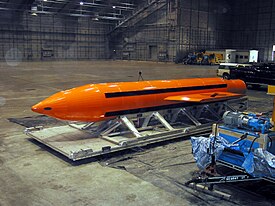
This is one of the largest weapons that can be deployed by the Alliance, carrying a supremely massive 132,000 pound warhead. An expensive, yet powerful, asset, the MOAB can, and most likely will, be deployed in conflicts which ground supremacy is a constant shift in control.


The Phlanax S-32 (or the S-32, as it's generally called), is an Anti-Ship Defense System, designed for close-combat with other naval vessels, as well as an Anti-ship missile defense, as well as proving to be effective against low-flying aircraft. The S-32 is a radar-guided 20 mm Gatling Gun mounted on a small, swiveling base, allowing it to have full movements. After it's development by Alliance Arms', it became a major asset, and is now deployed on all Alliance Surface ships.
Alliance Arms, after noting the effectiveness of such a weapon, also developed a ground version, the G-32. This weapon is usually used as Anti-missile defenses/air across the Alliance, but has also be known to be used against target ships.

The N7 Project is the newest one to come to light from the Alliance Arms' sets of projects. The primary goal of the N7 Project is to completely refit and rearm the Alliance Military, with brand new technology. As technology continues to advance, it is possible that the N7 Project continue, or that a whole new project take it's place. Either way, the beginning of the Alliance's ground-forces rearmament program has begun.
The project, authorized by the N7 Special Operations Command, was, in fact, named after the organization.

Like with all shotguns, the Crusader was designed to be a primarily short-range weapon. It's effectiveness declines the further away a target is, forcing the operator to remain close to the target. However, this shotgun is incredible with short ranges, and has been known to break through some of the most advanced body armors on the planet. The Crusader has been tested throughly, not just by Alliance Arms, but by the Alliance itself. Because those tests yielded that the Crusader was an amazing short-range weapon, it has been adopted as the Alliance's main combat shotgun.

The Eagle is the product of Alliance Arms' "N7 Project" that developed a close-in weapon to be used on armored targets with no loss of stopping power in comparison to the soldier's assault rifle. The Eagle enjoys a ballistics advantage even over most other pistols, and features an integral laser sight, visible only to Alliance soldiers, because of special systems in the helmets. Alliance Arms was incredibly careful when developing this weapon, knowing that it would be an important part of whatever fights the Alliance went into. Her tests were rigorous, and yet, the Eagle was victorious. Because of the test results, and the Eagle's impressive capabilities, the Alliance has adopted her as the main pistol.

The Valkyrie is a hybrid weapon with low heat production and an incredibly powerful punch. It's incredible ability to be able to aim and gun down targets with proficiency has made it a high-value part of the N7 Project for Alliance Arms. Many soldiers and arms designers did not believe that, during these times, Alliance Arms would be capable of producing a weapon more capable that it's previous XMX, including the rate of fire. The XMX had at it's disposal only full-auto, at times decreasing her accuracy. However, the Valkyrie, while having full-auto available, also has semi-auto and burst, giving her an advantage over several weapons. However, they've shown the new Valkyrie to have everything the XMX does available, and more. Countless more tests proved the rumors, and the Alliance approved it as her main assault rifle.

Featuring a complex recoil-reducing mechanism and high-grade auto-targeting software, the Hurricane delivers longer-range, more accurate fire than others in its class. Designed to have more armor-penetration than other SMGs, the Hurricane is capable of breaking through some of the more advanced body armors made in the world today, although it has been seen that there are a few armors that could stop on of their rounds. However, because of the accurate fire, and her rapid-fire capability, the Hurricane can easily fix that problem by sending more bullets to penetrate.
The Alliance has adopted this weapon as the main Sub-Machine gun.

While less accurate than the average assault rifle, the Phaeston was designed to be able to shoot more bullets faster than even the Valkyrie. Designed specifically to be a suppressive weapon, she can shoot nearly 700 rounds per minute, giving her a deadly amount of weapons fire. While technically a lower amount than the previous LMG, the Revenant seeks more accuracy as well, a large factor in any firefight.
The Phaeston was engineered to provide the best possible balance between accuracy and firepower in a machine gun. Each shot is tempered by kickback dampeners inside the shoulder stock, which lets the Phaeston pack more punch than other weapons its size without sacrificing precision. Its fully automatic fire and relatively light weight has turned the Phaeston into the Alliance infantry's primary go-to weapon.
The Phaeston has been adopted as the Alliance's main LMG.

Designed with Anti-personnel in mind, the Valiant is capable of shredding apart advanced body armors, capable of ripping a 5.56 round into the body of any being. However, it can also fire Anti-Material rounds, should it be needed, and any operators must be trained to use the weapon's functions entirely before being able to be deployed with her.
Significant amount of tests continued to produce good results, making the Valiant the new Alliance Sniper rifle.

The Defender Armor is a brand new design for body armor, built to protect soldiers in long-running engagements where reinforcements may be sparse. Because of recent advancements in technology, the designers added a special function: Whenever a gun was fired, the body armor's new integrated computer would calculate the recoil amounts, and support the arm to keep it level with it's target, increasing the accuracy.
The Helmet system, to ease the load on each soldier, has an integrated SMART system, effectively replacing the other forms available. Each helmet, to respond to the possibility that they can engage toxins on the battlefield, has an option to environmentally seal it, ensuring that any and all air is clean.
The Defender has a larger amount of space for clips than most other armors, giving a soldier a better ability to remain active in a firefight. The armor also comes with an injection system built into the suit (for medi-gel) and neural-linked bio-monitors that help adjust the wearer's breathing rate and adrenaline levels.
While not a weapon in the definition of the word, Alliance Arms had plans to design a way to allow soldiers ease when dealing with wounds. The outcome was Medi-gel.

Held in a small compartment in the back parts of the Defender Armor, Medi-gel uses injection systems across the entirety of the armor to direct medigel exactly to a wound.
It heals various wounds and ailments, instantly sealing injuries against infection and allowing for rapid healing by having the gel grip tight to flesh until subjected to a frequency of ultrasound. It is seal-able against liquids - most notably blood - as well as contaminants and gases, to ensure that no toxics can enter the bloodstream and further harm the soldier. Each armor can carry 2 packs of Medi-gel; Each pack of medi-gel carries 10 units. At first form, a soldier can seal 20 different wounds with the regular medi-gel packs that it immediately carries into combat. Those packs can be refilled or replaced later, should the need arise.
Medi-gel works in a very specific way; the soldier, whenever it is needed, orders to computer system in the helmet to send medi-gel to a specific area of the body. It automatically sends a unit of Medi-gel, and seals the wounds before toxins can get in. Medi-gel, in theory, can effectively save lives of soldiers on the battlefield.

The Cobra, while not part of the original plans for refurbishment in the Alliance military, it soon became a major part, as the threat of tanks and other armored vehicles became larger. To combat it, Alliance Arms designed and tested the Cobra, using advanced technologies and guiding to hit targets exactly where it is at it's weakest. While it is capable of destroying armored trucks, or IFVs, in a single blast, it is not as capable against a modern battle tank, requiring the combined firepower of several different launchers. Nevertheless, the Defense Council quickly examined the weapon themselves, and quickly began to produce it for the Alliance Armed Forces.

After countless tests had passed with the Valiant Sniper Rifle, Alliance Arms, and the Alliance Defense Council, determined that the weapon, while advanced and specialized at eliminating unprotected, or lightly protected, personnel, it was seemingly not enough to stop armored vehicles. Therefore, the Alliance, once more, contracted Alliance Arms to continue their impressive work, and design a penetrating weapon system to attack the more armored and fortified positions that enemy forces may or may not have.
The outcome was the Black Widow. An amazingly powerful rifle, this weapon's design allows it to rapidly fire bullets (to a certain extent), and, still, be capable of penetrating armor nearly half a meter thick. Easily, this rifle can break through trucks and fortified positions, and could even be a significant force in attempts to take out slow, hovering aircraft (though it is not adept, and only experts at firing a sniper rifle are capable of such shots).
After countless exams and tests of the weapons, the Alliance has officially accepted the Black Widow as her Heavy Sniper rifle.

![]() by Grand America » Fri May 25, 2012 2:53 pm
by Grand America » Fri May 25, 2012 2:53 pm
In an attempt to decrease the possibilities of any and all nuclear deterrence against the Capitol Alliance and the Coalition of Steel, the Alliance has begun the SLAMS Project.
SLAMS works using a laser system. The satellites fire a small, high powered energy laser down at the missile's body. It's designed to break through and burn it's internal systems, causing it to collapse, if it manages to survive the impact of a HEL.
It's basically a massive shield of satellites on the borders of the Alliance, several miles off coast, to be able to hit the missiles as they fly over the ocean, and headed for Alliance territory. This allows them to avoid the collateral damage of the HEL striking Alliance infrastructure.
L/B satellites can also detect launches, and alert SLAMS satellites guarding the sector that the missile's flight path crosses. ICBMs are an easy thing to plot flight paths for, but, for other missiles (ASATs, Cruise Missiles), the exact locations are fed to SLAMS, and they react accordingly.
Each SLAMS has it's one, massive laser to shoot down the main target, but, should an ASAT come at it from a side, it's equipped with several, smaller laser systems, to shoot those down, and protect themselves, being such a massive asset to Alliance protection.
However, even though the satellites were designed to shoot down missiles, they have limited effectiveness on aircraft, naval vessels, and poorly-armored vehicles.
However, in order for this to work, the Alliance constructed several up-links, each protected by a squad of Alliance JSF Infantry. This is because the Uplinks are actually military stations that watch over the area, disallowing an accidental firing of the satellite. The Uplink has a computer that will instantaneously warn the people inside if a missile is being fired in their respective areas (as uplinks only account for specific areas, though they can account for as much as an area the size of New York State in the Alliance), and request human confirmation for fire. However, SLAMS is not the only thing they are used for. They also allow Alliance to contact Logistical/Bombardment Satellites, which, while firing small precision lasers down on targets, are also used for Electronic Warfare, effectively firing an EMP into a designated area. They can also contact Air bases, and request for air support if it is needed, as well as reinforcements, calling in to the nearest Alliance Armored/Personnel base. While it will not always be the situation, they also have a Naval Comm system, which allows them to contact the nearest naval forces/base, and request naval support. Another feature of the Uplink building is the ability to, using a massive Laser system deep inside the building, to "crash" other systems. This can be crashing Aircraft Carriers, enemy satellites, tanks, and even aircraft, rendering them useless to manual control. This allows the men and women inside to combat the enemy using their own weapons. For example, an Uplink, if under attack, can crash and take control of an enemy fighter, effectively allowing them to fly and utilize the craft against it's allied states. This can also allow them to cut comms in and out of the aircraft, shut off weapons, and eliminate engines. This is extremely dangerous for Nuclear-Powered Aircraft Carriers, for, as soon as they crash it, they can destroy the power plant, effectively causing it to go into meltdown, a massive fear factor of the Uplink building. This allows an Uplink System (Normally from 6-10 Uplink buildings [the area in which they are situated are called Uplink Sites]) to call for any types of supports if it is ever needed.
The Uplinks themselves are extremely powerful. While only having the squad and just 4 turrets to defend themselves, they are made of an extremely resistant material, one that is classified, and never released to anyone. The workers that build them are specialists from Alliance Arms, allowing the Government to ensure the material is never released. This allows the building to survive amazing punishment, including constant artillery and tank fire on its walls. There are small walls to act as cover for the Uplink around it made from the same material. However, the areas above them are open, which are vulnerable to artillery attack coming from above. As a result, the squad can run inside the building, and close the doors, allowing them to protect themselves from the artillery/tank fire.
However, knowing the intense amount of technology that is taken into building the facilities, we knew that, eventually, someone would attempt to hack into the Uplink system and shut down the SLAMS and supports. The Uplinks systems was integrated into the Alliance Firewall, the most powerful in the world, to ensure its protection and the continued success of SLAMS, and the protection of Alliance soil. In an attempt to ensure that the Firewall was sufficient in the modern world, we contacted and contracted some of the best hackers in the world to attempt to break through the firewalls. Alliance officials watched them as they tried, and tried, and tried, to no avail. Each hacker, in a 4 month process attempted to break through nearly 510,000 times, and were always fought back by the Alliance Firewall programs. And every single time, END (ExtraNet Defense, the ExtraNet AI program) was able to track the signal, normally within 20 seconds, and once, in 16.
Knowing that EMPs and Biological, as well as chemical weapons, are a constant and dangerous part of the modern world, the Uplinks feature some of the most advanced Anti-EMP Warfare Programs in the world. They are capable of defending against EMP strikes, allowing, even in the heat of battle and EMP strikes, to contact Alliance Military Command, alert of the situation, and even use L/B Sats to fight back the opposing force. As for the B and C Weapons, they are sealed environments, to avoid contamination of the inner Uplink buildings.
Each building, excluding the squad and 8 turret gunners, have a total of 12 people (total of 40) working inside, working to ensure the elimination of enemy forces, in the event of an attack, or the protection of Alliance and Coalition Soil against nuclear and/or otherwise attack. The SLAMS, while primarily to disable nuclear powers, can also be used against fighter aircraft and Aircraft carriers, as they are precision satellites, allowing to hit even ground and air targets.

















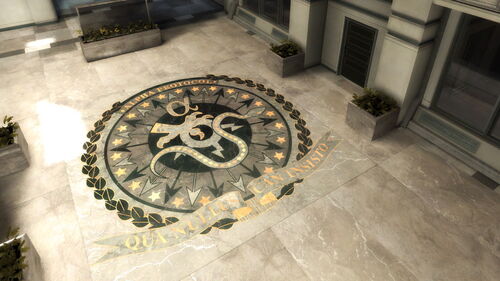
Alpha Protocol is a secretive organization within the Alliance government. Little is known about it, due to it and its operations being highly classified. While the number of operatives that Alpha Protocol employs is highly classified, AP operatives are geniuses in their chosen categories, whether it be an engineering, stealth, or fire fights. While AP has participated in fire fights, they excel in stealth and technical operations that push their operatives to the limit.
Not many within the government are aware Alpha Protocol exists, and this separation from the majority of Washington bureaucracy and oversight is intended to allow the Alliance to do operations on other nations without being able to be traced, erasing any and all red tape.
The Alpha Protocol insignia has some interesting symbolism, based on its description in the records. The ring of stars and arrows represents patriotism and military might, the eagle's talon is strength, the serpent is stealth and subterfuge, and the loose translation of the Latin phrase beneath it is, "Where No One Can Follow."
Alpha Protocol has and does give any gadgets, weapons, ammunition, and intelligence available to their operatives, though it is common that field operatives discover even more information to add to it's database. Of course, the fund transactions are done secretly, and using countless alias accounts as to not be traced to the agency. According to records, this means that since Alpha Protocol's inception, almost every field agent has had set up private safehouses, accounts, and armories for their own use. When an assignment is given, the safehouse is utilized to allow the operative to "lay low", and do research and gather information from contacts with safety. While the safehouses themselves use concealment to protect itself, each one, along side the AP operative, is assigned a set of computerized turret systems, and an AI, allowing full defense of the facility.
The leader of this agency is currently General Michael Thorton, who was once an AP Field Agent.
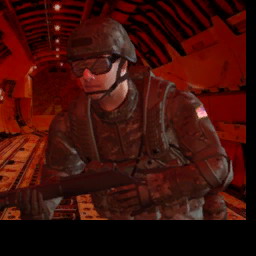
This branch of Alpha Protocol is responsible for all assault operations that AP agents cannot carry out on their own. Because the agents are so valuable, they often lead these fire-teams into combat operations instead of operating on their own. These specialists of combat go through some of the most rigorous combat training in order to be prepared to keep up with the agent in the field. They must have outstanding obedience, and must stand their ground for as long as possible, avoiding a retreat for as long as the agent needs suppressive fire.

Let Vigilance Be Our Sword
Third Echelon, sometimes referred to as "3E", or "3Ech", is a highly-advanced intelligence gathering branch of the Alliance Intelligence Agency. The exact location, or even the general location, of the Third Echelon command base is top secret information, only known to those who work there, and the Chairman. It's is, undoubtedly, the most forefront Intelligence asset in the so-called "War on Information." Third Echelon has done countless missions, and is the most valuable asset in the AIA, providing more information on world subjects than the other branches combined.
Third Echelon is the spear-head of the Alliance's information warfare initiative, allowing it to be the "Special Forces" of Information Warfare. This is largely because of her "Splinter Cell" addition, in which lone agents, called "Corsairs" do field operations across the world, gathering information in complete secrecy. Their work is the blackest of black ops, retrieving the most vital intelligence and acting on it in ways that other operatives cannot. While Third Echelon's activity cannot be denied, what operations are hers, and which aren't, are never exposed. Corsairs are like Shadows; Most workers in a 3E facility won't know their real names.
When intelligence deemed critical to national security cannot be obtained by traditional means, Third Echelon is granted clearance to conduct physical operations. No longer filtering the world through satellites and antennas, Third Echelon's "Splinter Cell" agents are sent to physically infiltrate dangerous and sensitive enemy locations to collect the required intelligence by whatever means necessary. Their prime directive is to conduct their operations while remaining invisible to the public eye. Their operations have never been seen, and it is likely to remain that way.
Third Echelon marks a return to more "classical" methods of espionage powered by the latest technology for the aggressive collection of information. In other words, it goes back to the grueling world of human spies operating out in the field, risking their lives for the sake of capturing a photograph, recording a conversation or copying a computer hard drive. Splinter Cell operatives are recruited from Alliance's many different branches, though most have some history as an N7, or a AIA agent. They are then shaped into the "ultimate covert soldiers": specially-trained individuals capable of not only working alone in hostile environments, but of doing so without leaving a trace. Like a sliver of glass, a Corsair is small, sharp, and nearly invisible. Thus, Third Echelon consists of an elite team of strategists, hackers, and field operatives that work together as a team to respond to crises of information warfare with the highest degree of secrecy humanly possible.
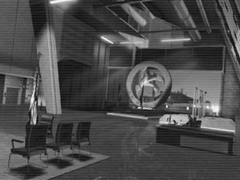
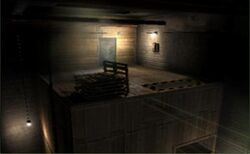
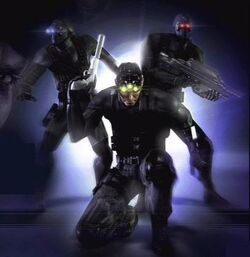

An evolution of the Alliance's Marine Expeditionary Unit, the Joint Strike Force is known for their integration of air and ground combat capabilities. Epitomizing the saying, high speed, low drag, this military-theater sized unit of elite soldiers excel in precision firepower and can rapidly deploy anywhere in the world. Moreover, their stealth technology and their ability to accurately gun down their targets are second-to-none. All JSF soldiers come from every branch of the Alliance military, as well as numerous intelligence agencies, and even private organizations.
Being trained with some of the most rigorous exercises on the face of the planet, the Joint Strike Force's Basic training is, among troops, called "The Visit to Hell." This, however, pushes only the best of the best to be able to work with said branch of the Alliance Marine Corps, allowing it to be the most advanced branch available in the Alliance ground military forces. Fielding both vehicles and troops, the JSF has been proven to be a force to be reckoned with.
Commanded by one General Scott Mitchell, the Joint Strike Force is the spear-head of Alliance offensive and defensive operations, and is kept as a high advantage of the Alliance armed forces.
32% of the Alliance Marine Corps' numbers are JSF troops.

![]() by Grand America » Fri May 25, 2012 2:54 pm
by Grand America » Fri May 25, 2012 2:54 pm
Advertisement
Return to Factbooks and National Information
Users browsing this forum: Gallia-, IC-Water, Indo States, Republica Federal de Catalunya
Advertisement